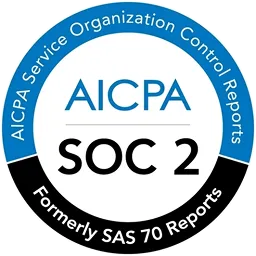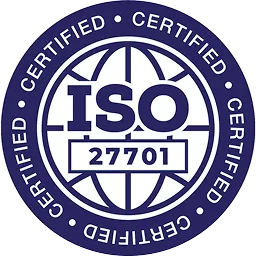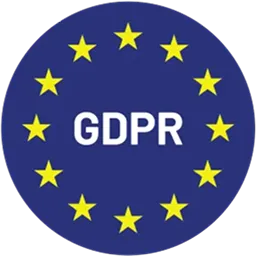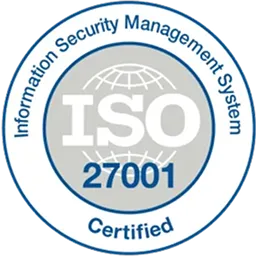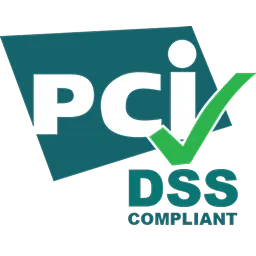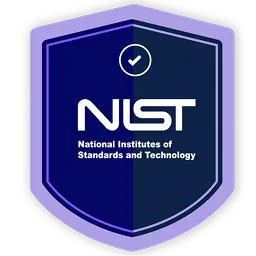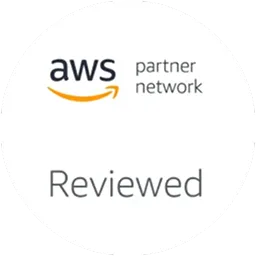Are your IT controls robust enough to protect your organization? Implementing controls is just the start; validating their alignment with regulatory requirements is the real challenge. This is where ITGC certification plays a crucial role. This article explains what all ITGC certification includes, how you can get it, and why it’s critical for compliance.
With strong IT general controls, you can identify and close compliance gaps, ensuring your systems are audit-ready.
For instance, imagine your organization undergoing a financial audit. If the auditors discover that ex-employees retain access to critical systems, it could result in fines, reputational damage, or even audit failures. ITGC certification helps you avoid such pitfalls by strengthening your controls and processes.
Before discussing the steps for obtaining ITGC certification, let’s first understand what it means and the compliance standards that mandate it.
What is an ITGC Certification?
ITGC certification is all about ensuring your organization’s IT systems are protected by solid, well-defined controls. These controls—known as IT General Controls (ITGC)—serve as the backbone of your IT environment. They help manage access to systems, track changes, and ensure smooth daily operations.
Certification is essentially a stamp of approval, confirming that your IT processes are secure, reliable, and meet industry standards.
The idea behind ITGC certification is simple: to give you and your stakeholders peace of mind. It’s not just about putting controls in place; it’s about validating that those controls are effective and aligned with what’s expected in your industry.
Whether it’s safeguarding sensitive information, reducing risks, or maintaining compliance, ITGC certification shows that your organization takes IT security and governance seriously.
Achieving ITGC certification isn’t just about checking a compliance box; it’s about strengthening your organization’s foundation and gaining confidence in your IT systems.
Duration of ITGC Certification & Who Helps You Obtain It
The ITGC certification typically takes around three weeks to complete. It includes training sessions, control implementation, and audits to verify compliance.
Now, the question arises: who audits these ITGCs? These are mainly conducted by external auditors who help your organization with the ITGC certification process. The auditors will assess your IT systems, identify compliance gaps, and certify your organization once it meets all standards.
Reputable external auditors include:
- Deloitte
- PwC (PricewaterhouseCoopers)
- KPMG
- Ernst & Young (EY)
Compliance Standards That Mandates IT General Controls
Let’s explore a few compliance standards that mandate ITGC controls in your organization.
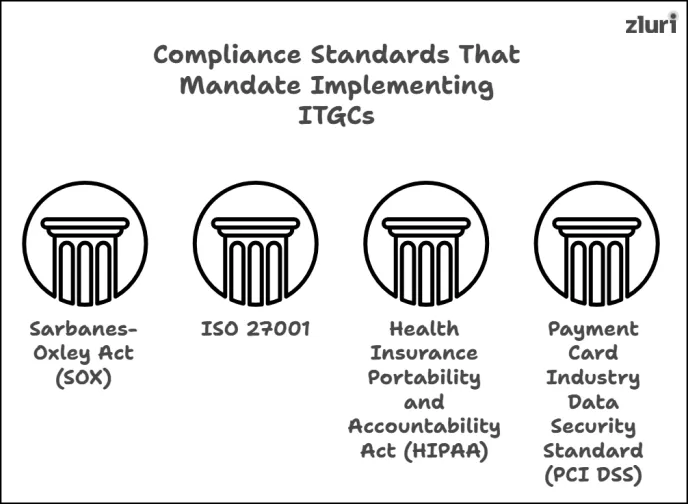
1. SOX
The Sarbanes-Oxley Act (SOX) regulates all publicly traded companies in the United States. It requires organizations to maintain accurate financial reporting and prevent fraud. IT General Controls (ITGC) play a key role in achieving these goals by ensuring financial systems and data security and integrity.
To protect financial information, SOX strongly emphasizes on implementing robust internal controls. ITGC contributes to this effort by introducing practices like access management, which limits authorized individuals' access to sensitive financial records. This reduces the risk of unauthorized modifications and helps preserve the accuracy and reliability of financial data.
Another essential component of ITGC is system monitoring, including automated logging. These tools track and document system changes, providing a clear audit trail. This functionality is key during SOX audits, as it shows who accessed or modified systems, when the changes occurred, and the purpose behind them. Such transparency is vital for demonstrating compliance and maintaining accountability.
By using ITGC measures like access controls and system monitoring, organizations can protect their financial data, promote accurate reporting, and reduce non-compliance risk. These controls also enhance transparency and help prevent potential penalties for SOX violations.
While ITGC alone doesn't guarantee full SOX compliance, it forms a solid foundation for the broader internal control framework needed to meet regulatory requirements. By integrating ITGC with other control measures, companies can achieve compliance and uphold trust in their financial reporting.
Also Read: Go through this to understand how you can achieve SOX ITGC Compliance.
2. ISO 27001
ISO 27001 is the international standard for managing information security. It helps protect sensitive data and reduces risks. It relies on the same principles that ITGC certification helps you reinforce, i.e., confidentiality, integrity, and availability. This is the reason why ITGC plays such a vital role in meeting ISO 27001 requirements.
- Confidentiality: ISO 27001 requires organizations to ensure that only authorized users can access sensitive data. ITGC certification helps achieve this by enforcing strong access controls. It ensures these controls are in place and functioning properly to keep unauthorized users out and prevent data breaches.
- Integrity: Maintaining data accuracy and reliability is another key focus of ISO 27001. ITGC supports this by implementing change management processes that require proper reviews and approvals before any updates or modifications. This reduces the risk of errors and unauthorized changes.
- Availability: ISO 27001 also emphasizes keeping systems operational and accessible when needed. ITGC certification helps here by introducing processes like performance monitoring and incident response. These measures help organizations quickly detect and resolve issues, minimizing downtime.
In short, ITGC certification demonstrates that an organization has implemented strong governance and operational controls, which are critical not only for ISO 27001 compliance but also for meeting other regulatory frameworks.
3. HIPAA
HIPAA—the Health Insurance Portability and Accountability Act—was created to protect patient information. It lays out strict guidelines for protecting sensitive health data, often called electronic Protected Health Information (ePHI). At its core, HIPAA is all about safeguarding privacy, strengthening security, and improving efficiency in healthcare operations. However, staying compliant can be a challenge. That’s where ITGC certification comes in—it simplifies the process and helps organizations stay on track.
- Protecting Privacy with Smart Access Controls: HIPAA is clear about one thing—patient data should only be accessible to authorized individuals. ITGC certification helps enforce this by ensuring you have systems like role-based access controls (RBAC) and identity management in place. More importantly, it verifies that these safeguards are working properly and are regularly reviewed to prevent unauthorized access.
- Securing Data Through Encryption and Monitoring: With cyber threats on the rise, protecting patient data has never been more important. HIPAA requires organizations to encrypt sensitive information and monitor for unusual activity. ITGC certification supports these efforts by validating the use of encryption tools, network monitoring systems, and audit logs. It also ensures you’re prepared to detect and respond to security incidents quickly—helping you stay ahead during audits.
- Improving Efficiency and Reducing Errors: HIPAA doesn’t just focus on security; it also pushes for better processes and fewer mistakes. ITGC certification backs this up by validating automated workflows and change control systems. These tools help streamline operations, reduce manual errors, and keep patient data accurate and reliable.
Getting ITGC certified shows that your organization takes security and compliance seriously. It’s more than just a requirement—it’s proof that you have the right technical safeguards and operational controls in place to meet HIPAA standards. Plus, it helps you stay audit-ready with continuous monitoring, risk assessments, and up-to-date documentation.
4. PCI DSS
If your organization handles credit card data—whether storing, processing or transmitting it—you need to follow PCI DSS, the Payment Card Industry Data Security Standard. Its main goals? Protect sensitive cardholder information, prevent fraud, and maintain customer trust. But compliance isn’t just about ticking boxes—it’s about creating a solid foundation for security. That’s where ITGC certification comes in.
ITGC certification helps you demonstrate compliance with PCI DSS and ensures that your security measures are effective and reliable.
- Protecting Cardholder Data: PCI DSS requires organizations to safeguard sensitive data with strict access controls. ITGC certification helps validate that you’re using role-based access, secure user authentication, and encryption protocols—and that these protections are regularly tested and monitored to keep data safe.
- Preventing Fraud Before It Starts: Fraud prevention is a core focus of PCI DSS. ITGC certification supports this by confirming that you have firewalls, network monitoring tools, and intrusion detection systems (IDS) in place to spot suspicious activity early and stop threats before they escalate.
- Managing Risks and Staying Prepared: PCI DSS also emphasizes risk management and incident response planning. ITGC certification ensures you have processes like change management, data backups, and audit logs in place. These safeguards help prevent errors, reduce fraud risks, and minimize data loss—keeping your systems secure and reliable.
Getting ITGC certified is like having a seal of approval that says your organization’s controls are secure, auditable, and ready for compliance checks. It proves you’re prepared for external audits and shows regulators and customers that you take data security seriously.
How to get an ITGC Certification For Your Organization?
Let’s understand the process of obtaining your organization’s ITGC certification.
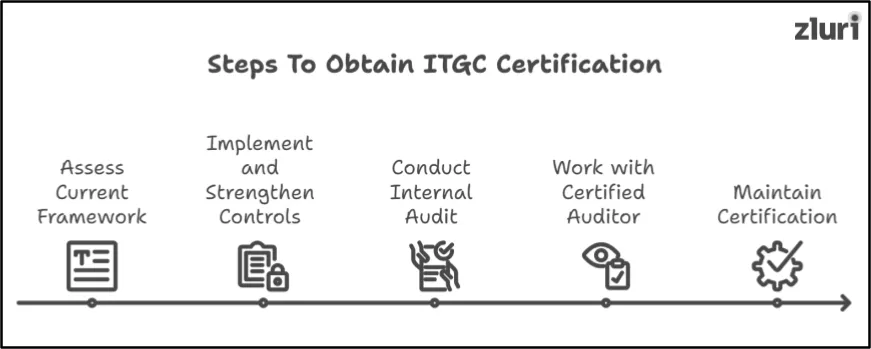
1. Assess your current ITGC framework
Before diving into the certification process, the first step is to take a close look at where your organization currently stands. Think of this as a health check for your IT controls. To do so, follow the below-given steps:
- Run a Gap Analysis: Identify what’s already in place and where the gaps are. Compare your current setup to industry standards like SOX, SOC, or ISO 27001.
- Review Policies and Procedures: Check whether your IT policies—like access controls, change management, and data backups—are up-to-date and effective.
Also Read: To prevent data loss, learn how to create a disaster recovery plan.
- Document Everything: Make sure your processes and controls are clearly documented. If something isn’t written down, it didn’t happen (at least not as far as auditors are concerned).
This example explains why assessing your ITGC framework is important.
Imagine your organization manages sensitive customer data, but you discover that some inactive user accounts haven’t been deactivated. This raises red flags for access control compliance under SOC 2. By identifying this gap early, you can take corrective action before auditors get involved.
This step sets the foundation for the rest of the process. Knowing what’s working and what’s not helps you prioritize what needs fixing.
Step 2: Implement and Strengthen Controls
Now that you’ve identified the gaps, it’s time to fix what’s broken and strengthen what’s weak. This is where you lay the groundwork for passing an audit. How to do so? Follow the below steps:
- Close the Gaps: Update your processes and put missing controls in place. For example:
- Add multi-factor authentication to secure access.
- Set up change management logs to track system updates.
- Improve disaster recovery plans to protect data.
- Focus on Documentation: Keep detailed records of policies, approvals, and processes. Auditors will ask for proof, so make sure it’s ready.
- Train Your Team: Ensure everyone involved understands their roles and responsibilities when it comes to compliance.
Why doing this is important? Let’s say your organization lacks a formalized change management process. You implement a system that requires documenting all IT changes, getting approvals before deployment, and logging any modifications. Now, you have a clear process to show auditors that changes are controlled and traceable.
This step prepares your organization for the formal audit. The better your controls and documentation, the smoother the process will be.
Step 3: Conduct an Internal Audit
Before bringing in an external auditor, evaluating your control with an internal audit is better. Think of this as a practice run to make sure everything’s in place.
- Test Your Controls: Check whether your controls are functioning as expected. For example, are user access permissions being reviewed regularly?
- Gather Evidence: Collect logs, reports, and approvals that prove your processes are being followed.
- Fix Any Issues: If something isn’t working, this is your chance to fix it before the real audit.
The example will explain better why conducting an internal audit is important: Suppose your internal audit reveals that employees with administrative privileges haven’t undergone periodic access reviews. You immediately implement quarterly reviews and document the results to fix the oversight before the external audit.
An internal audit gives you confidence that you’re ready for the formal assessment and reduces the risk of surprises during the actual certification process.
Step 4: Work with a Certified Auditor
Now it’s time for the real deal—the formal audit. This step involves working with a third-party auditor to assess your controls and determine whether you meet certification standards.
- Choose the Right Auditor: Look for someone experienced in your industry and the compliance frameworks you need to follow (e.g., SOX, SOC 1, SOC 2, ISO 27001).
Also Read: Confused between SOC 1 and SOC 2? Go through this to understand the difference.
- Provide Access and Evidence: Be ready to share your documentation, logs, and test results.
- Respond Quickly: If the auditor asks for clarifications or additional information, provide it promptly to keep the process moving.
Imagine your organization is undergoing a SOC 2 Type 2 audit. The external auditor requests evidence of employee offboarding procedures. You provide logs showing terminated employees had their access revoked within 24 hours. The auditor reviews this and confirms compliance with access management requirements.
A successful audit results in your official ITGC certification, showing stakeholders that your IT environment is secure and compliant.
Step 5: Maintain Certification
Getting certified is a big accomplishment, but staying certified is just as important. IT systems and compliance requirements are always changing, so ongoing maintenance is key. What can you do to achieve that? Follow the below steps:
- Schedule Regular Reviews: Perform periodic internal audits to catch issues early.
- Monitor Continuously: Use tools to track system activity, identify vulnerabilities, and prevent security incidents.
Also Read: Learn more about continuous monitoring with this blog.
- Keep Policies Updated: As regulations and technologies evolve, make sure your processes evolve, too.
- Train Your Team Regularly: Compliance isn’t a one-time thing—make sure employees stay informed about changes and best practices.
Let’s say your organization implements a new cloud-based storage system. To maintain ITGC certification, you conduct a risk assessment to evaluate whether the system complies with existing standards. You then update your access control policies and train the team on how to use the system securely.
Maintaining certification keeps you compliant and reduces the risk of security breaches, audit failures, and fines down the road.
Getting ITGC certification may take effort, but it’s a worthwhile investment in your organization’s security, compliance, and reputation. By following these steps—starting with a gap analysis and ending with ongoing maintenance—you’ll be well-prepared to pass audits and keep your IT systems in top shape.
Streamline Your Organization’s Internal Audit with Zluri
Getting ready for an external audit can be daunting. But why? It involves gathering a huge amount of data, documents, and evidence to show compliance. Thus, before even external auditors step in, you need to ensure that you have all this ready and your internal processes are in place (as mentioned above). A critical part of this advanced preparation is assessing whether your IT general controls (ITGC), like access control, are implemented correctly.
However, having an in-house team for this internal audit can be expensive (as it will cost you extra to provide training to the internal audit team), and the results might not be accurate (due to human involvement). Instead, you can opt for tools like Zluri to avoid the complexities (as discussed). Zluri offers an access reviews platform that can simplify the internal assessment process.
Imagine your organization wants to run an internal audit to check whether the access control measures implemented are aligned with SOX compliance requirements. With Zluri's access review solution, your team can audit user access to applications and resources at scheduled intervals.
Zluri helps you gain contextual insights into over-permissive access and identifies any potential gaps in your access control practices. This will ensure that only the right people can access sensitive systems and data. Basically, it helps you fix any issues before external auditors find them.
For instance, one of your team members left your organization six months ago. If their access to the IT systems wasn't revoked, it's a compliance risk. Zluri helps you detect these orphaned accounts and remediate them quickly. This way, you stay audit-ready and reduce risks.
What is the proof that you have run an internal audit? Don't worry; Zluri has a solution to this. Zluri allows you to generate access review reports. These reports can act as evidence for the external auditors to show your organization's commitment to compliance.
Let's take JumpCloud as an example to see how you can automate access review in Zluri.
Also Read: If you want to get compliant with SOX requirements, consider reading this: SOX compliance checklists.
Validate Your Compliance Efforts with ITGC Certification
ITGC certification does more than validate your compliance efforts. It empowers your organization to adopt best practices for IT governance. This certification ensures that your IT systems are secure and optimized for smooth operations.
Beyond meeting regulatory requirements, the certification gives your team a framework to improve efficiency. It helps you uncover hidden risks and streamline processes, making your organization more agile and resilient to change.
Investing in ITGC certification builds confidence among stakeholders, auditors, and customers. It signals your commitment to implementing the right IT controls.
Frequently Asked Questions (FAQs)
1. What is an audit engagement?
An audit engagement mainly refers to a binding agreement between an auditor and your organization. In this agreement, the auditor commits to give an unbiased view of your organization's financial records.
2. What is an operational audit?
An operational audit is a detailed evaluation of a company's activities and processes. It examines both daily operations and larger organizational practices. Unlike audits focused on finances or specific departments, an operational audit goes deeper. It aims to assess how effectively and efficiently the company operates as a whole.
3. What are the logical security controls?
Logical security controls are software-based measures designed to protect an organization's systems. They include user identification, password access, authentication processes, and access rights. These controls ensure that only authorized users can access information or perform specific actions on a network or workstation.


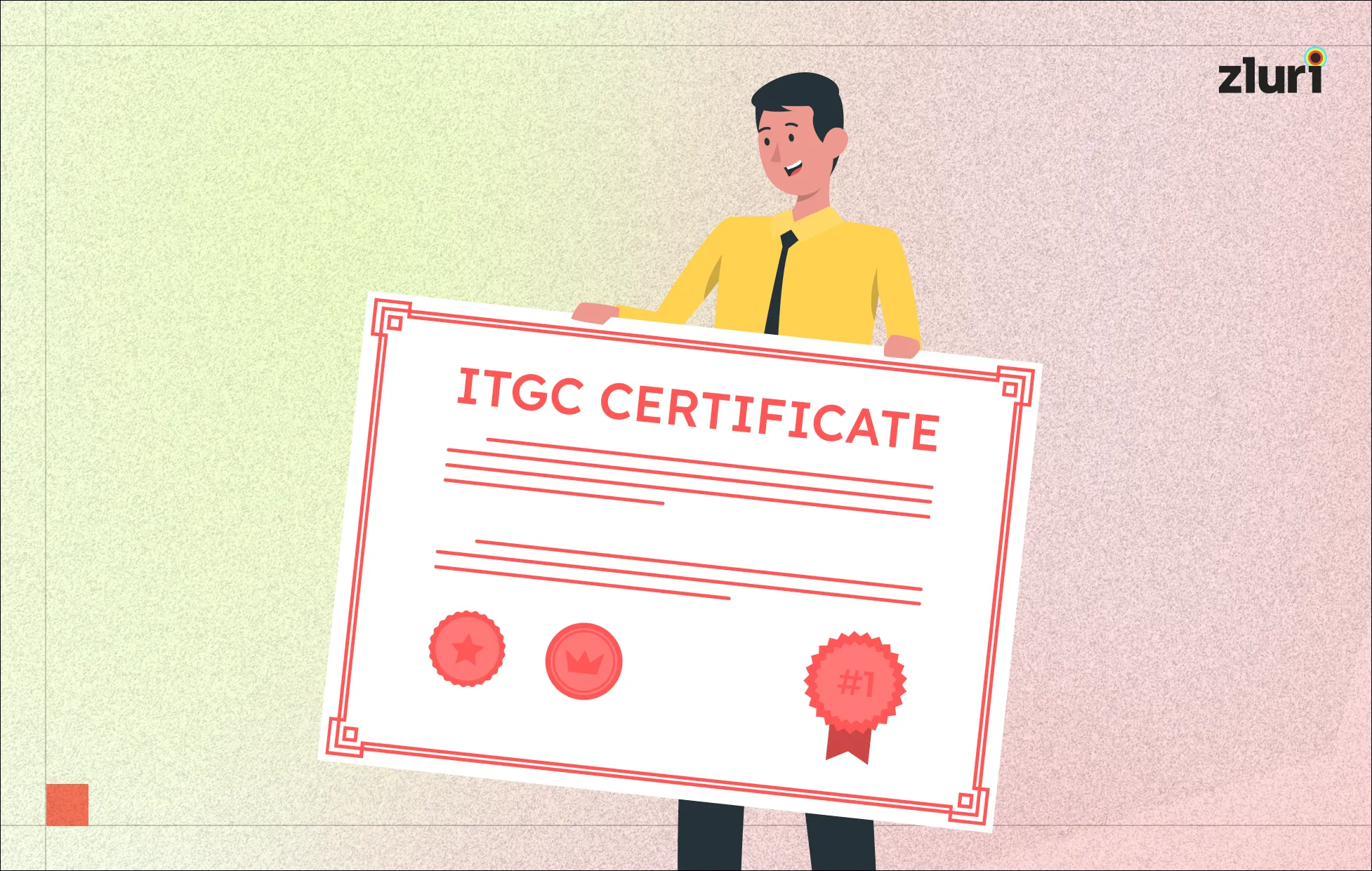



.svg)



